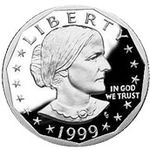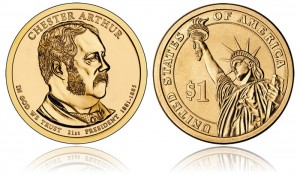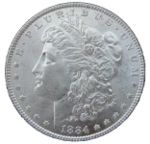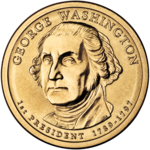Dollar| United States |
| Value | 1.00 U.S. dollar |
|---|
| Mass | 8.100 g (0.260 troy oz) |
|---|
| Diameter | 26.5 mm (1.043 in) |
|---|
| Thickness | 2.00 mm (0.079 in) |
|---|
| Edge | Plain with incised inscriptions |
|---|
| Composition | Copper with manganese brass clad (copper 88.5%,zinc 6%, manganese3.5%, nickel 2%) |
|---|
| Years of minting | 1796 – present |
|---|
| Catalog number | — |
|---|
| Obverse |
|---|
 |
| Design | Portraits of presidents, with a new coin released every three months |
|---|
| Designer | many |
|---|
| Design date | 2012 |
|---|
| Reverse |
|---|
 |
| Design | Statue of Liberty |
|---|
| Designer | Don Everhart |
|---|
| Design date | 2007 |
|---|
Dollar coins have been minted in the United States in gold, silver, and base metalversions. The term silver dollar is often used for any large white metal coin issued by the United States with a face value of one dollar, although purists insist that a dollar is notsilver unless it contains some of that metal. Silver dollars, the first dollar coin issue, wereminted beginning in 1794. Gold and gold-colored dollars have also been produced by the United States. The Sacagawea and Presidential dollars are referred to as "golden dollars".
Dollar coins have not been very popular in the United States, and most of the populace still currently use the one dollar bill.[1]
[edit]Popularity
The gold dollar (1849-89) was a tiny coin measuring only 13 mm making it difficult to grasp and easy to lose, a serious problem when a dollar was almost a day's wage.
Dollar coins have found little popular acceptance in circulation in the United States since the early 20th century, despite several attempts since 1971 to increase usage of dollar coins. This contrasts with currencies of most other developed countries, where denominations of similar value exist only in coin. These coins have largely succeeded because of a removal (or lack) of their corresponding paper issues[2], whereas the United States government has taken no action to remove the one-dollar bill, due to intensive lobbying.
The United States Government Accountability Office (GAO) has stated that discontinuing the dollar bill in favor of the dollar coin would save the U.S. government approximately $5.5 billion over thirty years primarily through seigniorage.[2][3]
[edit]Mint Marks
The mint marks are "C", "CC", "D", "D", "O", "P", "S", and "W".
[edit]History
[edit]Early dollar coins
Before the American Revolutionary War, coins from many European nations circulated freely in the American colonies, as did coinage issued by the various colonies. Chief among these was the Spanish silver dollar coins (also called pieces of eight or eight reales) minted in Mexico and other colonies with silver mined from Central and South American mines. These coins, along with others of similar size and value, were in use throughout the colonies, and later the United States, and were legal tender until 1857.
In 1776, the Continental Congress authorized plans to produce a silver coin to prop up the rapidly failing Continental—the first attempt by the fledgling US at paper currency. Several examples were struck in brass, pewter, and silver, but a circulating coin was not produced, due in large part to the financial difficulties of running the Revolutionary War. The Continental Dollar bears a date of 1776, and while its true denomination is not known, it is generally the size of later dollars, and the name has stuck. The failure of the Continental exacerbated a distrust of paper money among both politicians and the populace at large. The letters of Thomas Jefferson indicate that he wished the United States to eschew paper money and instead mint coins of similar perceived value and worth to those foreign coins circulating at the time.[4]
The Coinage Act of 1792 authorized the production of dollar coins from silver. The United States Mint produced silver dollar coins from 1794 to 1803, then ceased regular production of silver dollars until 1836. The first silver dollars, precisely 1,758 of them, were coined on October 15, 1794 and were immediately delivered to Mint Director David Rittenhouse for distribution to dignitaries as souvenirs.[5]Thereafter, until 1804, they were struck in varying quantities. There are two obverse designs: Flowing Hair (1794–1795) and Draped Bust(1795–1804). There are also two reverse designs used for the Draped Bust variety: small eagle (1795–1798) and heraldic eagle (1798–1804). Original silver dollars from this period are highly prized by coin collectors and are exceptionally valuable, and range from fairly common to incredibly rare. Due to the early practice of hand engraving each die, there are dozens of varieties known for all dates between 1795–1803.
It is also one of only two denominations (the other being the cent) minted in every year from its inception during the first decade of mint operation. However, the order was given by President Thomas Jefferson to halt silver dollar production due to the continued exportation of US dollars. The Spanish 8 Reale, which was slightly heavier than the US dollar, nonetheless traded at a 1-to-1 ratio. So US dollars went to the Caribbean, were traded for heavier 8 Reales, and those were then brought back to the US, where they would be recoined for free into more US dollars; the difference in silver, then, was kept by the exporter. This ensured that no dollars would circulate in the US, but would instead be exported for their heavier counterparts overseas, leaving little but old, foreign money to circulate in the United States in a process known as Gresham's Law.
[edit]The 1804 dollar
The 1804 silver dollar is one of the rarest and most famous and popular coins in the world.[6] Its creation was the result of a simple bookkeeping error, but its status as the king of coins has been established for nearly a century and a half. The silver dollars reported by the mint as being struck in 1804 were actually dated 1803 (die steel being very expensive in the early 19th century, dies were used until they were no longer in working condition. This is why many early US coins exhibit all kinds of die cracks, occlusions, cuds, clash marks, and other late state die wear. Dies were used until they literally fell apart. Nearly every coin the US struck from 1793 to 1825 has an example that was struck in a year other than that which it bears.) No dollars bearing the date 1804 were ever struck in 1804, though this was unknown to mint officials at the time the 1804 dollar came to be.
The 1804 silver dollar was actually produced in 1834, when the U.S. Department of State decided to produce a set of U.S. coins to be used as gifts to rulers in Asia in exchange for trade advantages. Since 1804 was the last recorded year of mintage for both the dollar and $10 Eagle, it was decided that the set would contain examples of those coins dated 1804, as well as the other denominations currently being produced. Mint officials, not realizing that the 19,000+ dollars recorded as being produced in 1804 were all dated 1803, proceeded to make new dies dated 1804. Little did they know the stunning rarity they were creating. Only 15 silver dollars with the date of 1804 are known to exist; in 1999, one of them sold at auction for more than $4 million. There are 8 Class I dollars, struck in 1834 for the aforementioned sets, 1 Class II dollar, struck over an 1857 Swiss Shooting Thaler (and now residing in the US Coin Collection at the Smithsonian Institution), and 6 Class III dollars, struck surreptitiously sometime between 1858 and 1860 to meet collector demand for the coin.
[edit]Seated Liberty dollar (1836–1873)
Seated Liberty Dollars were introduced in 1840 and were minted in larger quantities than the sparsely minted Gobrecht Dollar that preceded it. The dollars were used in general circulation until 1853. The production of large numbers of US gold coins (First $1 1849 and $20 in 1850) from the new California mines lowered the price of gold..so the value of silver rose. By 1853, the value of a US Silver Dollar contained in gold terms, $1.07 of silver. With the Mint Act of 1853, all US Silver coins, except for the US Silver Dollar and new 3 cent coin, were reduced by 6.9% as of weight with arrows on the date to denote reduction. The US Silver Dollar was continued to be minted in very small numbers mainly as a foreign trade to the Orient.
The international trading partners did not like the fact that U.S.A. coins were reduced in weight. The use of much more common half dollars became problematic since merchants would have to separate higher value pre-1853 coins from the newer reduced ones. From 1853 onwards, trade with Asia was typically done with Mexican coins that kept their weight and purity in the 19th Century. This ended in 1874 when the price of silver dropped so that a silver dollar has less than $1.00 worth of silver in it (huge amounts of silver coming from the Nevada Comstock Lode mines). By 1876, all silver coins were being used as money and by 1878, gold was at par with all US paper dollars. Beginning in 1878, huge amounts of the Morgan silver dollars were produced but few were used as money. The size was too large to carry on business so silver certificates were used instead. The mint made the coins, placed them in their vaults and issued the Silver Certificates instead. This is the reason so many Morgan and Peace dollars can be purchased in AU or UNC condition (near perfect)... they sat in bank/US Treasury vaults most of the time.
Each coin is composed of 0.77344 troy oz of silver. They were minted at Philadelphia, New Orleans, Carson City, and San Francisco. A Silver dollar is worth $1 in silver at $1.31 per troy ounce. Current silver price (October 21, 2010) is $23.12 per troy ounce so a silver dollar is worth, melted down (melt value) of about $17.88 US.
[edit]Gold dollar coins (1849–1889)
Main article:
Gold dollarThe gold dollar was produced from 1849 to 1889. 1849 to 1853 gold dollar coins were 13 mm across and are called Type I. Type II gold dollars were thinner but larger at 15 mm diameter and were produced from 1854 to 1855. The most common gold dollar are the Type III and started in 1856 until 1889. Production US $1 gold dollars was high until the Civil War and by 1863, only the larger value gold coins were produced large quantities. Most gold coins produced from 1863 and onward were produced for imports to pay for enormous amounts of war material and interest on some US Government bonds. Many of these coins from the Civil War and after (silver coins included) are in excellent condition since they saw very limited circulation with greenbacks and postage currency taking their place.
Composed of 90% pure gold, it was the smallest denomination of gold currency ever produced by the United States federal government. When the US system of coinage was originally designed there had been no plans for a gold dollar coin, but in the late 1840s, two gold rushes later, Congress was looking to expand the use of gold in the country’s currency.[7] The gold dollar was authorized by the Act of March 3, 1849, and the Liberty Head type began circulating soon afterward.[9] Because of the high value of gold, the gold dollar is the smallest coin in the history of US coinage.
[edit]Trade Dollar (1873–1885)
The Trade Dollar was produced in response to other Western powers, such as Great Britain, Spain, France, and particularly Mexico, to compete with these trade coins for use in trade in Asia. American Trade Dollars are 90% silver and weigh 420 grains (27.2 g), which is about 0.5 g heavier than the regular circulation Seated Liberty Dollars and Morgan Dollars. Most Trade Dollars ended up in Asia during their first two years of production, where they were very successful. Many of them exhibit chopmarks which are counterstamps from Asian merchants to verify the authenticity of the coins. Many trade coins of the western powers and large silver coins from China, Korea, and Japan also bear these chopmarks. While most chopmarked coins are generally worth less than those without, some of the more fascinating chopmarks can actually give the coin a modest premium.
Trade Dollars did not circulate in the United States initially, but were legal tender for up to $5. Things changed, however, in 1876, when the price of silver spiraled downward as western producers dumped silver on the market, making the Trade Dollar worth more at face value than its silver content. That resulted in Trade Dollars pouring back into the United States, as they were bought for as little as the equivalent of 80 US cents in Asia, and were then spent at $1 in the United States. This prompted Congress to revoke their legal tender status, and restrict their coinage to exportation demand only. However, this didn't stop unscrupulous persons from buying Trade Dollars at bullion value, and using them for payment as $1 to unsuspecting workers and merchants.
Production of the Trade Dollar was officially halted for business strikes in 1878, and thereafter from 1879–1885, produced only as proof examples of the coin. The issues of 1884 and 1885 were produced surreptitiously, and were unknown to the collecting public until 1908.
In February 1887, all non-mutilated outstanding Trade Dollars were made redeemable to the United States Treasury, and approximately 8 million of them were turned in.
[edit]Morgan dollar (1878–1904; 1921)
Main article:
Morgan DollarMorgan silver dollars were minted between 1878 and 1921, with a notable break between 1905 and 1920.[10] The 1921-dated coins are the most common, and there exists a substantial collector market for pristine, uncirculated specimens of the rarer dates and mint marks. Morgan dollars are second only toLincoln Cents in collector popularity. The coin is named after George T. Morgan, its designer. The mint mark is found on the reverse below the wreath, above the 'O' in 'DOLLAR'.
[edit]Peace dollar (1921–1935; 1964)
Main article:
Peace DollarIntroduced in December 1921, the Peace dollar, designed by medalist Anthony de Francisci, was promulgated to commemorate the signing of formal peace treaties between the Allied forces andGermany and Austria.[11] These treaties officially ended the Allies' World War I hostilities with these two countries. In 1922 the Mint made silver dollar production its top priority, causing other denominations to be produced sparingly if at all that year. Production ceased temporarily after 1928; original plans apparently called for only a one year suspension, but this was extended by the Great Depression. Mintage resumed in 1934, but for only two years.
In May 1965, 316,000+ Peace Dollars were minted, all at the Denver Mint and dated 1964-D; however, plans for completing this coinage were abandoned, and most of those already minted were melted, with two known trial strike specimens being preserved (for assay purposes) until 1970, when they too were melted, and none released either for circulation or collection purposes. It is rumored that one or more pieces still exist, most notably any examples obtained by key members of Congress, the President, or mint officials. However, this coin, much like the 1933 $20 gold Double Eagle (aside from the "exception", sold in 2002 for over $7 million), is illegal to own and would be subject to confiscation.[12]
[edit]Release of dollars by the US Treasury: the GSA sale
Because of the size and weight of the dollar coins, they circulated minimally throughout their history, except in the West (especially at casinos in the early-to-mid-20th century, where they were commonly used both at the tables and at slot machines.) As a result, the coins were generally shipped to Washington and stored in the vaults of the US Treasury; at times these stores numbered into the hundreds of millions.[citation needed]
They were very popular as Christmas gifts, however, and from the 1930s to the early 1960s, many bags were annually released to banks nationwide to be distributed as presents. In November 1962, during this annual distribution, it was discovered that there were some rare and valuable dates, still sealed in their original mint bags, all in uncirculated condition, among the millions of dollar coins still in the Treasury vaults. Collectors/investors/dealers lined up to purchase them in $1,000 bags, trading silver certificates for the coins. Before this event, the great rarity of the Morgan series was 1903-O, which was by far the most expensive of the entire set. It was discovered that there were millions of this specific date and mint in the Treasury vaults; an estimated 84% of the entire mintage sat in these bags, untouched for 60 years, all in uncirculated condition. While still relatively expensive in circulated grades, uncirculated examples can be had for a modest amount over common dates.[citation needed]
On March 25, 1964, Secretary of the Treasury C. Douglas Dillon announced that Silver Certificates would no longer be redeemable for silver dollars.[13] Subsequently, another act of Congress dated June 24, 1967, provided that Silver Certificates could be exchanged for silver bullion for a period of one year, until June 24, 1968.[14]
Following this, the Treasury inventoried its remaining stock of dollar coins, and found approximately 3,000 bags containing 3 million coins. Many of the remaining coins were Carson City mint dollars, which even then carried a premium. The coins were placed in special hard plastic holders and the General Services Administration (GSA) was given authorization to sell them to the public in a series of mail-bid sales. Five sales were conducted in 1973 and 1974, but sales were poor, and the results unspectacular. There was much complaining among the coin buying public, many stating that the United States Government should not be in the "coin business", especially considering that the government had spent little more than a dollar to mint and store each coin. After these sales, more than a million coins were still left unsold.
These sat again until 1979-1980, where, amidst an extraordinarily volatile precious metals market, the remaining coins were sold under chaotic conditions. The GSA, having published minimum bids in November 1979, announced on January 2, 1980, that those minimum bids were no longer valid, and that prospective bidders would have to "call in" to a toll free number to get current minimum bids. Then, on February 21, 13 days after the bidding process officially began, the maximum number of coins per bidder was changed from 500 to 35. Many bidders, under these confusing conditions, ended up with no coins at all. Complaints again flooded in to Congress, but the damage had already been done, and the last silver dollars held by the United States Treasury were gone.[15][16][17]
Over the years, many of these GSA dollars have been broken out of their special holders for purposes of grading or otherwise, and now GSA dollars still in the unbroken original holders carry a small premium. Some third party grading companies have begun to grade coins still in their GSA holders, as a means of preservation, though this is not without controversy.[18]
[edit]Eisenhower dollar (1971–1978)
From 1971 to 1978, the U.S. Mint issued dollar coins with the obverse depicting Dwight D. Eisenhower and the reverse the insignia of the Apollo 11 moon landing, both designed by Chief Engraver Frank Gasparro.[19]The 1976 Bicentennial commemorative design, produced in 1975 and 1976, featured the Liberty Bell and the Moon on the reverse (designed by Dennis R. Williams), while retaining the Eisenhower obverse, and the dual dates 1776-1976. The Eisenhower dollars minted for general circulation contained no silver or gold, but were instead composed of the same copper-nickel clad composition used for the dime, quarter, and half dollar. This made the circulation coins extremely resistant to wear and, like the smaller denominations, they still retain a good deal of shine even when subject to mass usage.
From 1971 through 1976 the Mint also produced dollars composed of 40% silver aimed at the collector market. The 1971-74 issues appeared in brown boxes or blue packages, depending on whether they were proof or uncirculated. Somewhat different Bicentennial sets were produced in the following two years. All issues remain very common.
The coins were never very popular, primarily due to their large size and weight which made them inconvenient to carry and the fact that very few vending machines were designed to accept them. They saw the greatest use in casinos, and one-dollar tokens in United States casinos still approximate the size and weight of the coins. Prior to the withdrawal of the coins, which remain legal tender (and are sometimes available at banks by request[citation needed]), many casinos did not strike their own tokens, but instead used the Eisenhower dollar.
[edit]Susan B. Anthony dollar (1979–1981; 1999)

The Anthony clad dollar, 1979.

The Anthony clad dollar, 1999.
From 1979 to 1981, and again in 1999, the Mint produced Anthony Dollars, depicting Susan B. Anthony, the first non-fictitious woman portrayed on circulating U.S. coinage. (Many earlier circulating coins featured images of women, but the women depicted were all non-specific representations ofLiberty. Spain's Queen Isabella was portrayed on the 1893 Columbian Exposition quarter dollar, but it was not intended as a circulating coin, although some did circulate.) The Anthony dollars, like the Eisenhower dollars, were made from a copper-nickel clad. The 1981 coins were issued for collectors only, but occasionally show up in circulation.
The Anthony dollar was often confused with quarter based on color and it being not much larger than one. This is one reason why the coin was never popular. It was quickly discontinued, but resurrected in 1999 when Treasury reserves were low, and the Sacagawea dollar was still a year away from production.[20] While reserves of the coins were initially high, the coins were in demand to be used as change in vending machines, most often in transit systems and post offices.
This dollar is often referred to as a "Suzy" or "Susie"[citation needed]; another variation is to refer to the coin as a "Susan B" or "Susie/Suzy B;" another common term is the "Carter quarter,"[citation needed] referring to its emergence during the Presidential term of Jimmy Carter and the fact that it was often confused with the quarter-dollar coin.
[edit]Sacagawea dollar (2000–present)
 | |  |
Obverse (left) of the current Sacagawea Dollar and reverse (right) of the original Sacagawea Dollar, 2000-2008 |
The Sacagawea dollar was authorized by Congress in 1997 because the supply of Anthony dollars, in inventory since their last mintage in 1981, was soon expected to be depleted. Delays in ramping up Sacagawea dollar production led to a final 1999-dated mintage of Susan B. Anthony dollars. Dollar coins are used infrequently in general commerce. They used to be given as change by United States Postal Service stamp vending machines, which created a relatively small but significant demand, but the USPS eliminated all those machines by 2010.
The obverse was designed by artist Glenna Goodacre. Since no verifiable image of Sacagawea exists, Goodacre used Randy'L He-dow Teton, aUniversity of New Mexico college student and a Shoshone Indian, as a model for the coin.[21]
There are approximately 1 billion Sacagawea coins in circulation, and about 250 million in reserve. The US Mint greatly reduced production of Sacagawea dollars after the 2001 minting, citing sufficient inventory. From 2002 to 2008 the Sacagawea dollar was still minted for collectors and was available in uncirculated rolls, mint sets, and proof sets, but it was not released for general circulation until the introduction of the Native American series in 2009.
The Mint took great care to create the coin with the same size, weight, and electromagnetic properties as the Anthony dollar, but with a golden color. Unlike most other coins in circulation, the selected alloy has a tendency to tarnish quite severely in circulation, as is the case with most brasses, resulting in a loss of the golden shine, except on raised areas where the "patina" is more frequently rubbed off.[22] While some consider the blackening an undesired quality, the Mint suggests the uneven tarnishing effect gives the coins an "antique finish" that "accentuate[s] the profile and add[s] a dimension of depth to the depiction of Sacagawea and her child".[22]
The coin featured a plain edge through 2008, but starting in 2009 incused lettering was applied. The year and mint mark moved from the coin's obverse (front) to its edge.
As of 2011, dollar coins are not widely encountered in US commerce, except in vending machines for rides on mass transit, some pay and display machines, some laundromats, and old-fashioned slot machines. Most vending machines and parking meters have been redesigned, however, to accept dollar coins for purchase over a quarter-dollar.[citation needed] The Sacagawea dollar has achieved popularity in El Salvador, Ecuador and Panama, where the US dollar is also the official currency.[20]
[edit]Native American series
 | |  |
The Sacagawea dollar reverse for 2009 (left) representing agriculture and the reverse for 2010 (right) representing government |
With the passage of the Native American $1 Coin Act[23] on September 20, 2007, the U.S. Mint began designing a series of Sacagawea dollars with modified reverses to further commemorate "Native Americans and the important contributions made by Indian tribes and individual Native Americans to the development of the United States and the history of the United States". Four designs were to be minted, each for one year from 2009 to 2012. The first Native American series coin was released in January 2009 and had a reverse that depicted a Native American woman sowing seeds of the Three Sisters, symbolizing the Indian tribes' contributions to agriculture.
Like the Presidential Dollar, the year of issue, mint mark, and motto E Pluribus Unum are found on the edge of the coin instead of on the obverse or reverse, which allows for more room for the design.[24] Unlike the Presidential $1 coins from before 2009, "In God We Trust" remains on the obverse and the vacant space on the edge lettering has been taken up by thirteen stars, symbolizing the Thirteen Colonies. Also, unlike any other denomination of circulating U.S. coinage (but in common with the Presidential $1 coins), the value is inscribed in numerals on the reverse. The act passed by Congress requires that 20% of the total dollar coins minted in any year during the Presidential $1 Coin Program be Sacagawea dollars bearing the new design.
In January 2010, the second reverse design in the series was released which has the theme of "Government" and the "Great Tree of Peace". The 2010 Sacagawea reverse depicts the Hiawatha Belt and five arrows bound together representing unity with the inscription "Haudenosaunee", a synonym for the Iroquois Confederacy meaning "People of the Longhouse". Another inscription is found along the lower edge of the reverse spelling "Great Law of Peace" (an English translation of Gayanashagowa, the Iroquois Confederacyconstitution). The Great Law of Peace was used as a model for the Constitution of the United States. The four links on the belt are meant to symbolize four of the five Nations of the Iroquois Confederacy, namely the Mohawk, Oneida, Cayuga and Seneca Nations. TheEastern White Pine tree in the middle of the belt represents the fifth Nation, the Onondaga, and is a depiction of the Tree of Peace.
[edit]Presidential Dollar Coin (2007–present)
In December 2005, Congress decided to create a new series of $1 coins which will honor the former U.S. presidents. In 2007, Presidential coins of four different designs were produced. Another four designs will be produced each year, honoring the Presidents in order of service. (Grover Cleveland will be on two coins, since he served two non-consecutive terms.) The Presidential $1 Coin Act is intended to create renewed interest in the coin like that seen during the 50 State Quarters program.[25] At least one third of all dollar coins produced are still Sacagawea coins, with the remaining coins making up the four presidential coins annually. Under federal law (31 U.S.C. § 5112), no coins may be issued featuring a living president, or a president who died less than two years earlier. The program was scheduled to run until 2016, but was canceled to save money.
The presidential dollar coin is the same size and composition as the Sacagawea dollar. "In God We Trust", the issue year, and the mint mark appear on the edge.[26] The fact that these national mottoes appear on the edge has caused some conservative commentators to decry the designs.[27][28] The first dollar, honoring George Washington, was released into circulation on February 15, 2007. However,H.R. 2764 became law on December 26, 2007 which moved "In God We Trust" from the edge to the obverse.
A common minting error on this coin, estimated at 80,000, from a mintage of 300,000,000 coins, is the omission of the edge lettering causing a plain outside edge.[29][30] Because the omission includes the words "In God We Trust", some in the popular media have dubbed it the "godless" coin.[31] A false (although at one time widely reported) error is the report that the edge lettering is upside down. The edge lettering does not occur at the same time as the minting of the coins, allowing for the natural occurrence of the lettering in either orientation,[citation needed] except Proof Coins where the date and lettering are all "right-side-up."
Because of budget constraints and increasing stockpiles of the relatively unpopular coins, the production of new Sacagawea and presidential dollar coins for circulation was suspended on December 13, 2011. Future minting of such coins will be made solely for collectors.[32]































